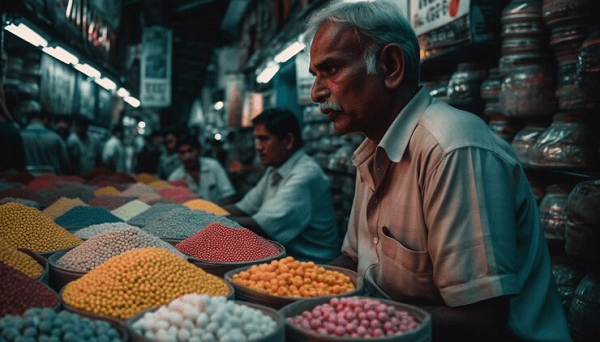Indian thickening agents- Indian cuisine features a variety of thickening agents that are used to add texture and consistency to dishes. These thickening agents can be natural or processed ingredients. Here are some common ones:
- Besan (Gram Flour): Besan is a finely ground flour made from chickpeas and is commonly used as a thickening agent in Indian cuisine. It’s used in dishes like kadhi, pakoras, and some gravies.
- Cornstarch: While not traditionally Indian, cornstarch is sometimes used as a thickening agent in Indian cooking, especially in fusion dishes and Indo-Chinese recipes. It’s used to make sauces and gravies thicker and smoother.
- Rice Flour: Rice flour is used as a thickening agent in some South Indian dishes, particularly in dishes like dosa, idli, and appam, where it helps achieve the desired consistency.
- Arrowroot: Arrowroot powder is occasionally used in Indian cuisine to thicken soups, sauces, and desserts. It’s a neutral-tasting thickening agent that doesn’t affect the flavor of the dish.
- Cashew Paste: Cashew nut paste is often used to thicken and add creaminess to Indian gravies and curries, especially in North Indian cuisine.
- Yogurt/Curd: Yogurt or curd is commonly used as a thickening agent in Indian dishes like curries and kadhi. It imparts a tangy flavor while thickening the sauce.
- Coconut Milk: Coconut milk is used to thicken and add richness to South Indian and coastal Indian dishes. It’s often used in curries and stews.
- Poppy Seed Paste: Poppy seed paste is used as a thickening agent in Bengali cuisine, where it adds a unique flavor and texture to dishes.
- Makhana (Foxnuts) Paste: Makhana paste is used in North Indian cuisine, particularly in creamy gravies and curries. It adds a creamy and nutty texture.
- Mustard Paste: Mustard paste is used in Bengali and some North Indian dishes to thicken curries and add a distinctive flavor.
- Ground Nuts: Ground peanuts are used in dishes like Gujarati kadhi and some Maharashtrian preparations to thicken the gravies.
- Tomato Paste: Tomato paste or puree is commonly used as a thickening agent in many Indian dishes, especially in tomato-based gravies.
- Besan, Maida, or Cornflour Slurry: A mixture of water and any of these flours is often used to thicken gravies and sauces.
The choice of thickening agent often depends on the region, the specific dish, and individual preferences. Each thickening agent can contribute its own unique flavor and texture to the dish, so the selection of the appropriate one is important to maintain the authenticity and taste of the recipe.
What is Indian thickening agents
In Indian cuisine, various ingredients are used as thickening agents to add texture and consistency to dishes. These ingredients help to create the desired thickness and mouthfeel in gravies, soups, and desserts. Here are some common Indian thickening agents:
- Besan (Gram Flour): Besan, a finely ground flour made from chickpeas, is commonly used to thicken sauces, curries, and gravies. It is a staple in dishes like kadhi and some vegetable curries.
- Cornstarch (Cornflour): Cornstarch is a neutral-tasting thickening agent used in many cuisines, including Indian. It is often used in Indo-Chinese dishes, soups, and some Indian desserts to achieve the desired consistency.
- Rice Flour: Rice flour is used in South Indian cuisine to thicken preparations like dosa, idli, and appam batters. It helps achieve the right texture in these dishes.
- Arrowroot: Arrowroot powder is occasionally used as a thickening agent in Indian cooking, especially in gluten-free and Jain recipes. It imparts a glossy and smooth texture to sauces and gravies.
- Yogurt (Curd): Yogurt or curd is a popular natural thickening agent used in many Indian dishes, such as curries, kadhi, and marinades. It also adds a tangy flavor to the preparations.
- Coconut Milk: Coconut milk is commonly used to thicken and add creaminess to South Indian and coastal Indian dishes. It is a key ingredient in various curries and stews.
- Cashew Paste: Cashew nut paste is often used to thicken and add richness to North Indian gravies and curries. It also imparts a creamy texture.
- Poppy Seed Paste: Poppy seed paste is used in Bengali cuisine as a thickening agent in various dishes. It contributes a unique flavor and texture to the preparations.
- Tomato Paste: Tomato paste or puree is a common thickening agent in many Indian gravies, particularly in tomato-based dishes. It also adds a tangy note to the flavor.
- Ground Nuts: Ground peanuts are used in dishes from regions like Gujarat and Maharashtra to thicken gravies and add a nutty flavor.
- Mustard Paste: Mustard paste is used in Bengali and North Indian cuisine as a thickening agent in some curries and adds a distinctive flavor.
- Maida (All-Purpose Flour) or Maida Slurry: A mixture of water and maida (all-purpose flour) is often used to thicken gravies and sauces in various Indian recipes.
The choice of thickening agent depends on the type of dish and regional preferences. Different thickening agents may impart unique flavors and textures to the dishes, so the selection of the appropriate one is essential to achieve the desired outcome and maintain the authenticity of the recipe.
Who is Required Indian thickening agents
Indian thickening agents are commonly required in Indian cooking to achieve the desired texture, consistency, and flavor in various dishes. These agents play a crucial role in many Indian recipes, especially in curries, gravies, soups, and desserts. Here’s why they are required:
- Consistency: Thickening agents are used to achieve the right consistency in dishes. They help transform watery or thin gravies into rich, creamy, and thick sauces that coat the ingredients.
- Mouthfeel: These agents enhance the mouthfeel of dishes. They make gravies and curries smoother and more palatable, giving them a satisfying texture.
- Flavor: Some thickening agents, like cashew paste, coconut milk, or tomato paste, contribute unique flavors to the dish, enhancing the overall taste and aroma.
- Cultural and Regional Authenticity: Different regions of India have their own traditional thickening agents that are integral to the authenticity of regional dishes. Using the appropriate thickening agent helps maintain the cultural and regional identity of the cuisine.
- Versatility: Thickening agents are versatile and can be used in a wide range of Indian recipes, from vegetarian curries to meat-based dishes and even desserts.
- Texture Enhancement: Thickening agents help control the texture of dishes like dosa and idli batters, ensuring they have the right consistency for cooking.
- Adaptation to Special Diets: Some thickening agents, like rice flour or arrowroot, are used to cater to specific dietary needs, such as gluten-free or Jain cooking.
In summary, Indian thickening agents are required to transform the texture and flavor of various dishes while staying true to regional traditions and cultural authenticity. They are essential tools in the Indian culinary repertoire for achieving the desired culinary results.
When is Required Indian thickening agents

Indian thickening agents are typically used in a variety of situations and recipes to achieve the desired consistency and texture. Here are some common scenarios and dishes where Indian thickening agents are required:
- Curries and Gravies: Thickening agents are often used to make curry and gravy bases thicker and creamier. They help the sauce adhere to the main ingredients and create a rich, flavorful coating. This is especially important in dishes like butter chicken, palak paneer, or chicken korma.
- Stews: In South Indian and coastal cuisine, coconut milk is used to thicken and add richness to stews, such as Kerala-style fish curry or Goan vindaloo.
- Soups: In dishes like rasam or sambar, a mixture of toor dal (pigeon peas) and tamarind is used to thicken the soup and give it a hearty consistency.
- Batters: In South Indian cuisine, rice flour or urad dal (black gram) is used to thicken and provide the right consistency for batters used in dishes like dosa, idli, and vada.
- Kadhi: Kadhi, a yogurt-based dish, relies on besan (gram flour) to thicken the gravy and give it a smooth, creamy texture.
- Desserts: In Indian sweets like kheer (rice pudding) or payasam, thickening agents like rice or vermicelli are used to achieve the desired consistency.
- Indo-Chinese Cuisine: Cornstarch is frequently used as a thickening agent in Indo-Chinese dishes, such as manchurian or sweet and sour sauces.
- Gluten-Free or Jain Cooking: Arrowroot or rice flour may be used as thickening agents in recipes for those with dietary restrictions, such as gluten-free or Jain diets.
- Bengali Cuisine: Poppy seed paste is used in traditional Bengali recipes to thicken and flavor dishes like posto (poppy seed curry).
- North Indian Creamy Gravies: Cashew paste is often used to thicken and add a creamy texture to gravies in North Indian cuisine.
- Tomato-Based Dishes: Tomato paste or puree is commonly used to thicken gravies in dishes like butter chicken or tomato-based curries.
In summary, Indian thickening agents are required in a wide range of Indian recipes to achieve the desired texture and consistency, depending on the dish and regional variations. They are versatile ingredients that play a crucial role in Indian cooking.
Where is Required Indian thickening agents
Indian thickening agents are commonly used in various regions of India to enhance the texture and consistency of a wide range of dishes. These agents are utilized in different culinary traditions and recipes across the country. Here are some regions where Indian thickening agents are commonly required:
- North India: North Indian cuisine often uses thickening agents like besan (gram flour), maida (all-purpose flour), and cashew paste in creamy gravies and curries. These agents help create the thick, rich sauces characteristic of dishes like butter chicken and paneer tikka masala.
- South India: South Indian cuisine relies on rice flour and urad dal (black gram) to thicken the batters used for making dosa, idli, and vada. Coconut milk is also used to add creaminess to coconut-based curries and stews.
- West India: In the western state of Gujarat, besan is a key ingredient in many dishes, including kadhi, dhokla, and fafda. It’s used both as a thickening agent and a flavor enhancer.
- East India: Bengali cuisine often uses poppy seed paste as a thickening agent and flavoring agent in dishes like posto (poppy seed curry) and shorshe bata (mustard-based curries).
- Coastal Regions: Coastal areas of India, such as Kerala and Goa, commonly use coconut milk as a thickening agent to create creamy and flavorful curries, such as fish curry and vindaloo.
- Indo-Chinese Cuisine: Indo-Chinese dishes, popular across India, use cornstarch as a thickening agent in sauces like manchurian and sweet and sour. These dishes have a unique fusion of Chinese and Indian flavors.
- Special Diets: Thickening agents like arrowroot and rice flour are used in recipes for individuals with dietary restrictions, such as those following gluten-free or Jain diets.
- North Indian Sweets: Indian sweets like kheer (rice pudding) and rabri use thickening agents to achieve the desired consistency and texture.
- North Indian Kadhi: Kadhi, a yogurt-based dish, is thickened using besan and is a staple in North Indian cuisine.
- Tomato-Based Gravies: In various regions, tomato paste or puree is used to thicken and add a tangy flavor to tomato-based gravies and curries.
The use of thickening agents can vary within regions and from one recipe to another, but they play a vital role in shaping the flavors and textures of traditional Indian dishes.
How is Required Indian thickening agents
Indian thickening agents are used to modify the texture and consistency of various dishes in Indian cuisine. The specific method for using these thickening agents can vary depending on the ingredient and the dish being prepared. Here’s how some of the common Indian thickening agents are typically used:
- Besan (Gram Flour): Besan is often used in North Indian curries and dishes like kadhi. To use besan as a thickening agent, it is usually mixed with water or yogurt to form a smooth paste or slurry. This paste is then added to the cooking pot, and the mixture is simmered until the desired thickness is achieved.
- Cornstarch (Cornflour): Cornstarch is commonly used in Indo-Chinese dishes and some Indian sweets. To thicken a sauce or gravy with cornstarch, it should be first mixed with a small amount of cold water to form a slurry, and then gradually added to the hot liquid while stirring. The mixture is simmered until it thickens.
- Rice Flour: In South Indian dishes like dosa and idli, rice flour is mixed with urad dal (black gram) and water to create a batter. The batter is then fermented and used to make dosa and idli after achieving the right consistency.
- Arrowroot: Arrowroot is often used in gluten-free and Jain cooking. To use arrowroot as a thickening agent, it is mixed with water to form a slurry and then added to the dish. It thickens quickly, so it should be added towards the end of cooking.
- Yogurt (Curd): In dishes like kadhi, yogurt is used as a base. It can be whisked with besan or other spices and then added to the curry. The yogurt mixture is stirred well and simmered until the curry thickens.
- Coconut Milk: Coconut milk is used as a base in many South Indian and coastal Indian dishes. It is added to the curry or stew, and as it simmers, it naturally thickens the dish.
- Cashew Paste: Cashew paste is often used in North Indian cuisine to thicken and add creaminess to gravies. Cashews are soaked, ground into a paste, and added to the dish towards the end of cooking.
- Poppy Seed Paste: In Bengali cuisine, poppy seed paste is mixed with other ingredients to form a paste, which is added to curries to thicken and flavor the dish.
- Tomato Paste: Tomato paste or puree is commonly used in tomato-based gravies. It is added to the dish and simmered until the desired thickness and flavor are achieved.
- Maida (All-Purpose Flour) or Maida Slurry: To use maida or a maida slurry as a thickening agent, it should be mixed with water to create a smooth paste and then added to the dish. The mixture is simmered until it thickens.
The specific method for using thickening agents can vary from recipe to recipe, so it’s important to follow the instructions provided in the recipe you are preparing. The goal is to achieve the right consistency and flavor while ensuring that the thickening agent is evenly incorporated into the dish.
Case Study on Indian thickening agents
The Use of Besan (Gram Flour) as a Thickening Agent in Indian Cuisine
Background: Besan, also known as gram flour, is a staple ingredient in Indian cuisine and is widely used as a thickening agent in various dishes. This case study focuses on the role and significance of besan as a thickening agent in Indian cooking.
Objective: To explore the traditional and contemporary use of besan as a thickening agent, its cultural and regional variations, and its adaptability to modern dietary preferences.
Methodology:
- Traditional Usage: Investigate the historical use of besan in Indian cooking. Analyze its role in regional cuisines, such as North Indian, Gujarati, and Rajasthani cuisine.
- Versatility: Explore the various dishes where besan is used as a thickening agent, including kadhi, besan ke laddoo, dhokla, and various vegetable curries.
- Cultural Significance: Assess the cultural and regional importance of besan in Indian cuisine. Understand its role in festive and celebratory dishes.
- Adaptation to Modern Diets: Examine how besan is adapted to cater to modern dietary preferences, such as gluten-free and vegan cooking.
Findings:
- Historical Significance: Besan has been a key ingredient in Indian cuisine for centuries. It has been used traditionally to thicken curries, gravies, and desserts. Its history is deeply rooted in Indian culinary traditions.
- Regional Variations: Besan is used in different ways across regions. In North India, it is a key ingredient in kadhi, which is a yogurt-based curry thickened with besan. In Gujarat, besan is used in dhokla and the famous thepla. In Rajasthan, it’s used in dishes like gatte ki sabzi.
- Versatility: Besan is incredibly versatile and is used in a wide range of dishes. In addition to thickening agents, it also serves as a flavor enhancer and adds a nutty, earthy taste to the dishes in which it is used.
- Cultural Significance: Besan-based dishes are often associated with celebrations and festivals. For instance, besan ke laddoo is a popular sweet prepared during Diwali, and kadhi is a common dish served on special occasions.
- Adaptation: Besan has been adapted to modern dietary preferences. It is often used in gluten-free and vegan recipes as a substitute for wheat flour. Additionally, it has gained popularity as a high-protein ingredient in health-conscious diets.
Conclusion: Besan, or gram flour, is a versatile and culturally significant ingredient in Indian cuisine. Its traditional use as a thickening agent in a variety of regional dishes showcases its deep-rooted importance. Additionally, besan has successfully adapted to modern dietary trends, making it a prominent ingredient in contemporary Indian cooking. Its adaptability and rich history make it a cornerstone of Indian culinary traditions.
White paper on Indian thickening agents
Abstract:
Indian cuisine is renowned for its diverse flavors, regional variations, and the skillful use of spices and ingredients. Among these, the incorporation of thickening agents plays a significant role in shaping the texture, consistency, and taste of Indian dishes. This white paper explores the key thickening agents commonly used in Indian cooking, their historical significance, regional variations, and their adaptability to modern culinary practices.
I. Introduction:
Indian cuisine is a rich tapestry of flavors and traditions, with each region contributing unique ingredients and techniques. The use of thickening agents is a common thread that runs through Indian culinary practices. These agents are essential in achieving the desired texture, whether it’s a creamy North Indian curry, a South Indian stew, or a traditional sweet. Understanding the use of thickening agents is vital to appreciating the depth and diversity of Indian cuisine.
II. Common Indian Thickening Agents:
- Besan (Gram Flour): Besan, derived from chickpeas, is a versatile thickening agent used in various regional cuisines. It forms the base for dishes like kadhi and pakoras.
- Cornstarch (Cornflour): While not native to India, cornstarch is often used in Indo-Chinese cooking to thicken sauces and in desserts for a smooth texture.
- Rice Flour: South Indian cuisine relies on rice flour to thicken batters for dosa and idli, as well as in other traditional dishes.
- Yogurt (Curd): Yogurt is a common thickening agent in dishes like kadhi, adding a tangy element along with its thickening properties.
- Coconut Milk: Coastal regions extensively use coconut milk to add creaminess and thicken curries and stews.
- Cashew Paste: Cashew nut paste is popular in North Indian cooking, contributing to the creaminess of gravies like butter chicken.
- Poppy Seed Paste: Bengali cuisine often uses poppy seed paste for thickening and flavoring dishes.
- Tomato Paste: Tomatoes are used for both their flavor and thickening properties, particularly in tomato-based gravies.
III. Historical Significance:
The use of thickening agents in Indian cooking dates back centuries. These agents have been integral to the development of regional cuisines and are deeply rooted in Indian culinary traditions.
IV. Regional Variations:
Different regions of India have their own thickening agents, reflecting the diverse landscapes and culinary practices. For instance, besan is prevalent in North Indian cuisine, while coconut milk is favored in coastal areas.
V. Adaptability to Modern Culinary Trends:
Indian cuisine is not static but dynamic. Thickening agents have adapted to modern dietary trends, such as gluten-free and vegan cooking. For instance, besan is often used as a gluten-free substitute for wheat flour.
VI. Conclusion:
The use of thickening agents is a fundamental aspect of Indian cooking. These agents, both traditional and adapted to modern needs, contribute to the richness and complexity of Indian cuisine. Understanding their significance and versatility enhances one’s appreciation of the culinary heritage of India. As Indian cuisine continues to evolve, these agents will remain a vital component of its diverse and dynamic culinary landscape.
Industrial Application of Indian thickening agents
Indian thickening agents, such as besan (gram flour), cornstarch, and various regional thickeners, find applications beyond culinary uses. These thickening agents can be employed in various industrial sectors for their thickening, binding, and stabilizing properties. Here are some industrial applications:
- Textile Industry:
- Starch-based thickeners, including cornstarch, are used in textile printing and dyeing to control the viscosity of the printing paste, ensuring precise designs and patterns on fabrics.
- Pharmaceutical Industry:
- Starch derivatives like cornstarch are utilized in the pharmaceutical sector for their binding properties in tablet formulations. They help maintain the structural integrity of tablets.
- Paper Industry:
- Starch and its derivatives are used as surface sizing agents to enhance the strength and smoothness of paper products. This application ensures better print quality and paper strength.
- Adhesives and Glues:
- Starch-based adhesives and glues are used in various industries, such as packaging, bookbinding, and construction, for their binding and adhesive properties.
- Cosmetics and Personal Care Products:
- Starch-based thickening agents are used in cosmetics and personal care products like creams, lotions, and shampoos to provide the desired texture and consistency.
- Paints and Coatings:
- Modified starches are employed as thickeners in the production of paints and coatings, which help control the viscosity and improve the application of these products.
- Oil and Gas Industry:
- Xanthan gum, a microbial thickening agent, is used in drilling fluids to increase viscosity and provide lubrication and stability in oil and gas drilling operations.
- Mining Industry:
- Modified starches are utilized as flocculants and thickeners in mineral processing to separate valuable minerals from waste materials.
- Biotechnology and Pharmaceuticals:
- Agar-agar, a natural thickening agent derived from seaweed, is used in microbiological media for the growth and cultivation of microorganisms in laboratories.
- Construction Industry:
- Starch-based adhesives are used in the construction of wall coverings, wallpapers, and wall panels, providing strong adhesion.
- Paints and Coatings:
- Thickening agents like hydroxypropyl methylcellulose (HPMC) are used in paint and coating formulations to control the viscosity and improve the application properties.
- Personal Care and Cosmetics:
- Thickening agents are used in the formulation of personal care products such as shampoos, conditioners, and lotions to achieve the desired consistency and texture.
- Pharmaceuticals:
- In addition to tablet binding, starch-based thickeners are used as disintegrants in pharmaceutical tablets to promote their dissolution.
Indian thickening agents and starch derivatives are valued for their effectiveness and versatility in a wide range of industrial applications. They play a crucial role in improving product quality, performance, and overall efficiency in various sectors.





